WEDNESDAY'S SCRIPT TIP:
THE SPARK OF LIFE

Your story has to start somewhere, right?
You have a protagonist - a really great character that you have created and just can't
wait to get them involved in a story. You've come up with a whole bunch of great
scenes, too... but how do you get your story started? You need one of those things
screenwriting gurus call "the inciting incident". Can you just come up with some random
event that kicks things off? All you need is something to get your protagonist into
trouble, right? Something that creates a conflict so that you can use all of those cool
scenes you've come up with. Can you just flip through a newspaper and find an inciting
incident?
Nope. That's the scene that sparks the whole story - the entire rest of the script will be
about that scene. If you think about chase thriller movies like MINORITY REPORT and
BOURNE IDENTITY those scenes that trigger the chase end up being what the story is
really about - they are thematic. Those movies are not about the chase scenes, they
are about destiny and identity... the elements created by the inciting incident. That
event is the spark of life for your screenplay... and that spark determines everything
else in the story!

In MINORITY REPORT what gets the hero on the run is the system which sees crimes
in advance - it is never wrong - and it sees that the hero will kill a man. That not only
sets our hero on the run, it's also what creates the theme and every single scene that
follows. It's not just an excuse to get the story started - it's the scene that CREATES the
rest of the story. The spark of life.
The reason why they are after the protagonist, the goal for the protagonist (the way he
will prove he's innocent will be in that scene), the theme, and the emotional conflict for
the protagonist. That's the whole danged story! You have to come up with the inciting
incident that uses the themes that YOU want to explore. That way you're telling YOUR
story and not some random story that has nothing to do with your protagonist and your
scenes. That spark of life is the CAUSE OF THE CONFLICT and that makes it the
CAUSE OF THE STORY. You can't just pick something at random out of a newspaper,
you have to carefully select the incident that will spark the story you want to tell.
The spark of life in THE FUGITIVE sets up the entire rest of the movie. Everything
comes from the scene where his wife is murdered and that WAY his wife is murdered.
1) The one armed man is sent to kill Dr. Richard Kimble - but he's not home. So the one
armed man kills Kimble's wife....
2) Kimble comes home, fights with the one armed man... who escapes.
3) Kimble's wife dies... and all of the evidence points to Kimble as the killer. He is the
only one who saw the one armed man.
4) The rest of the film is Kimble searching for the one armed man who killed his wife.
He is the only one who believes the one armed man exists.
5) No one will believe Kimble about the one armed man... and therein lies the theme -
Lt. Girard doesn't believe Kimble... but grows to believe him as the story goes on.
6) When he finally discovers one armed man, he also discovers that he (Kimble) was
the intended victim... because he discovered the false data in the drug research.

So the murder of his wife and the method by which she was killed is what CREATES
the rest of the story in THE FUGITIVE. The thing that sets the story in motion - the Inciting Incident - is too
important to leave to some random idea. The spark of life in a rom-com is the thing that
brings them together AND keeps them apart - that's going to be the most important
thing in your entire script! It's fate in SERENDIPITY, it's that road trip in WHEN HARRY
MET SALLY, it's the wedding in MY BEST FRIEND'S WEDDING. You really need to
give it a great deal of thought because it is the thing that creates the rest of the story
and contains the theme the whole script will be exploring. That is the scene that gives
your story life so treat it with the reverence it deserves.
Since that spark, the inciting incident, is what *creates* your story, your story can't really start
until we've had that spark, right? Before the spark is before the story. Pre-story. How much pre-story can
we have before the audience begins to fidget in their cinema seats and wonder when something is going to happen?
THE INCITING INCIDENT
The inciting incident is that element that creates the conflict... and story is conflict, so you can't really have a story without one. There are two theories on inciting incidents: character and story, and we look at both in my TERMINATOR book.

The Character version has the inciting incident be when the conflict reaches the protagonist... when the protagonist is forced to deal with the conflict, struggles with the conflict, and eventually must solve the conflict (or maybe the conflict “solves them” and the bad-guys win if this is a tragedy). This version opens with the protagonist in every day life and follows them until the conflict reaches them... which may be a quarter of the way into the story. Unfortunately, in poorly structured stories it is often even later.
The Story version has the inciting incident when the conflict is created, even if the protagonist isn’t involved yet. Because we begin with the conflict and then see the protagonist in their every day life, tension is created as the conflict grows closer and closer to the protagonist and eventually engulfs them. We still get all of the character scenes, but now they are more exciting because we know that conflict is out there.
I prefer the Story version, because it ensures that we get to the conflict quickly and don’t have a couple dozen minutes of boring character stuff where there is no conflict.
THE TERMINATOR is a great example of the Story version, because it begins with the introduction of the antagonist (the Terminator) and that gives us instant conflict. A strange electric storm and the Terminator (Arnold Schwarzenegger) appears - naked - rises up, walks to look over all of Los Angeles below. The naked Terminator walks up to the three punks (one is the late Bill Paxton, who was a regular in James Cameron films) at the Griffith Park Observatory playing with a coin operated telescope, what’s wrong with this picture? “Nice night for a walk, eh?” The Terminator repeats that. “Wash day tomorrow? Nothing clean, right?” The Terminator repeats that as well, and since they’re on the subject, “Your clothes... give them to me, now.” One of the punks pulls out a knife, “Fuck you, asshole!” The Terminator punches his hand *into* that punk and lifts him off of his feet... then drops him to the ground. He gets the clothes. A version of this scene plays out in most of the movies - the “birth” of the Terminator.
Had we used the Character version, we might have started our story with Sarah Connor, waitress; and shown her life... she goes to work, she has a roommate, she gets stood up on a date, she goes out for pizza alone, she sees on the news that someone is killing women named Sarah Connor... and now we have a conflict.
But that pizza parlor scene happens over 26 minutes into the film. Do you really want to watch 26 minutes of Sarah’s life without any real conflict? Okay, there’s that kid in the restaurant she works in who puts ice cream in her pocket, and she then gets stood up on a date, and her pet lizard gets loose... but those are not the type of conflicts that make a story. Sarah is a normal person leading a normal life... a boring life. The problem with focusing on her normal life for the first quarter of the story is that it is boring. Mundane. The sort of life that the audience lives. Heck, if they wanted to see that, they could have saved buying a ticket and stayed at home.
If you look at the basic concept of this film it is all about the Terminator being sent back in time to kill Sarah, not about Sarah’s day-to-day problems. So the Story version of Inciting Incident is the only thing that makes sense... and the Character version is usually where Act 2 kicks in. We want to start our story when the conflict starts... and that’s when the Terminator arrives and does his unusual clothes shopping.
So when is our inciting incident? Well, technically it is probably in 2029 when Skynet decides to send the Terminator back to kill Sarah. Before the movie even starts! But for purposes of this story, it’s when the Terminator shows up to hunt Sarah - which is the beginning of the movie... or maybe when Kyle Reese grabs a phone book and looks up Sarah Connor eleven minutes into the film. That’s when we know that this typical young waitress is actually the center of the storm that is coming her way. And in that 10 minute range is about right for an inciting incident.
This brings up another basic element of how this story works... and how all stories work. If story is conflict and the antagonist brings the conflict... the antagonist is the most important character in your story. There *isn’t* a story in this film without the Terminator. The first three films in this series are about an assassin from the future sent back in time to kill our protagonist, and the relentless chase and action which ensues. If you remove those three different Terminators, what’s the story? The big problem with the fourth film was that there was no antagonist... and it just meanders. No matter what the genre, a story needs an antagonist or a force of antagonism that creates the conflict and drives the story.
A story needs an active antagonist (or force of antagonism) - who is the villain, what is their plan? In most action and thriller scripts, the villain's plan is what fuels the plot. What Sarah Connor’s goals are isn't nearly as important as what the Terminator's goal is - to kill every woman in Los Angeles named Sarah Connor. Even Kyle Reese's goal - to stop the Terminator - is a reaction to the villain's plan. You can't stop what hasn't started or what doesn’t exist! If you removed the villain's plan, Reese has no reason to go back in time (and John Connor would never have been born - what a conundrum!) This makes the villain or antagonist or force of antagonism the most important character in your script.
Because the villain's plan is the fuel for the story, that plan has to be something that makes sense. It must be well motivated and *understandable*. On the surface, killing every woman in Los Angeles named Sarah Conner seems crazy... but we learn that one of these Sarahs will give birth to John Connor, who will lead the attack against Skynet in the future. So killing all of these women named Sarah Connor is an act of self preservation for the Terminator. That's a motivation we understand - it makes sense. If the villain's plan doesn't makes sense, neither will your story. The key to a great villain is having them fully fleshed out, even if that flesh is over a metal ectoskeleton. Though the audience may never consciously stop to think about the Terminator’s motivation, it makes sense on a subconscious level. I always say that you don’t have to tell the audience what the antagonist’s motivation is, but the writer has to know in order to keep the character consistent. We have to know what makes our characters tick.
Some structure methods like Hero’s Journey use the character version of Inciting Incident and spend the first quarter of the story in the protagonist’s normal life... and though that might work on some stories where the protagonist has an exciting normal life, it doesn’t work well if the protagonist is as ordinary as their ordinary world. The same year that TERMINATOR was released, we met Axel Foley in BEVERLY HILLS COP in his ordinary world... with a character scene showing just how relentless and possibly crazy Foley is when catching crooks. If the character is interesting enough you can start your story showing their normal life.
We need to open our stories in an exciting and involving way or we will lose the audience and the reader... and if we have lost the reader there is probably never going to be a reader! So it is important to hit the ground running - to begin any story regardless of genre with something that will hook the reader. It doesn’t have to be a naked killing machine from the future, it could be a girl who has never really been kissed dreading her upcoming 16th birthday, or a gadget salesman looking for the perfect gift for his son in a Chinatown curio shop (to name two other hit films from the year TERMINATOR was released). We want to get to the “good part” of our stories as quickly as possible. If you have an ordinary character in an ordinary world, like Sarah Connor, waiting 25 minutes or 25 pages before anything interesting happens is liable to make the audience walk out or the reader stop reading. So in most cases, starting with story not only makes the script more exciting to read, it makes the normal life of the protagonist more involving. When we see Sarah Connor as this waitress with roommate problems leading her boring life, we wonder how she will ever survive this killing machine from the future! The contrast tool kicks in. We know how dangerous the conflict is because that was introduced first... and *this* is the person who must defeat that conflict? Now every boring part of her life reinforces how much danger she is going to be in when the story and character intersect 26 minutes into the film. Starting with the story conflict creates suspense during the scenes where the character is introduced.
As I point out in the “Hook ‘Em In Ten” Blue Book - what makes AMERICAN BEAUTY work is that we know from the first minute that the protagonist will be killed in one year - that this is the last year of their life. That turns a normal character into a fascinating character. This guy is gonna die! Knowing that the Terminator is killing everyone named Sarah Connor turns her from someone like you or me into the most interesting character on earth. Why her? That creates mystery as well as suspense around the character. Why is this killing machine from the future coming after a waitress with roommate issues? By starting with the conflict, we actually increase the interest in the character and make the story *more* character focused.
That’s just the beginning of the first film, the book looks at theme and action scenes and characters and everything else in the all five films in the TERMINATOR movies and previews the new film DARK FATE. We want to start our story when the conflict starts... and that's when the Terminator arrives.
THE FUGITIVE doesn't begin with a half hour of Kimble and his wife living their every day life and then have her killed on page 26, it begins with conflict... and the specific conflict that sparks the rest of the story!
That spark of life not only creates the begining of your story, it creates the end and everything in between.
BRAND NEW!
How Do I do That?

101 SCREENWRITING ANSWERS Blue Book!
New to screenwriting? You probably have questions! How do I get an Agent? How do I write a phone conversation? Do I need a Mentor? What’s does VO and OC and OS mean? What is proper screenplay format? Should I use a pen name? Do I need to movie to Hollywood? What’s the difference between a Producer and a Production Manager, and which should I sell my script to? How do I write a Text Message? Should I Copyright or WGA register my script? Can I Direct or Star? How do I write an Improvised scene? Overcoming Writer’s Block? How do I write a Sex Scene? And many many more! This book has the answers to the 101 Most Asked Questions from new screenwriters! Everything you need to know to begin writing your screenplay!
All of the answers you need to know, from a working professional screenwriter with 20 produced films and a new movie made for a major streaming service in 2023!
Only $4.99
NEW!!!
Can You Make It bigger?

BLOCKBUSTERS (and BEACH READS) Blue Book!
Writing something EPIC?
ONLY: $4.99!
Thinking about writing a big Disaster Movie? An Historical Epic? An Epic Adventure Film? Or maybe you like Gladiator Movies? This book looks at writing Blockbusters and those Big Fat Beach Read novels - anything epic! Usng movies like JAWS, POSEIDON ADVENTURE, LAWRENCE OF ARABIA, THE GUNS OF NAVARONE, and those MARVEL and FAST & FURIOUS flicks as examples. What *is* a Blockbuster? 107 years of Blockbuster history! Blockbuster Characters. Blockbuster Story Types! Why modern Blockbusters are soap operas! Social Issues in Blcokbusters? Big Emotions! Keeping All Of Those Characters Distinctive! How to avoid the Big problems found in Big Movies and books! More! If you are writing a Big Event Movie or a Big Fat Novel, there are tips and techniques to help you!
Only $4.99
BRAND NEW!
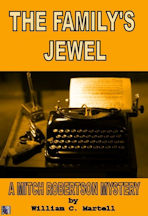
***
MITCH ROBERTSON #2: THE FAMILY'S JEWEL *** - For Kindle!
"The Presidential Suite of the Hollywood Hoover Hotel looked like a bloody battlefield: bodies everywhere, furniture broken, red liquid dripping from the walls, dead soldiers littering the elegant Berber rug as clouds of smoke overhead bounced between two air conditioning vents.
Mitch Robertson stepped over the body of an ex-child star turned sex tape star turned pop star and entered the room, spotted a gun on the floor and picked it up... careful not to spill his coffee with three pumps of mocha syrup from Penny’s Coffee Shop. That coffee was gold, the only thing keeping him going in this dazed state of wakefulness. The gun felt light. Holding it, he saw the silhouette of an 80s action star sitting sideways on a tipped over chair. Motionless. Was he dead? Mitch was still hung over from the Awards Party the night before, and wondered whether this was all some sort of crazy nightmare that he would wake up from... but when he tripped over the brown legs of a bottomless Superhero, flaccid junk encased in a condom but still wearing his mask, and hit the edge of the sofa, gun skittering and coffee spilling, he realized that it was all very real. What the hell had happened here?"
Short Novel. Only 99 cents - and no postage!
IT'S NEW!!
All About Rewrites!
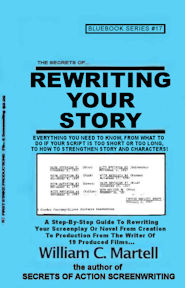
REWRITES Blue Book!
Rewriting In Waves?
When You Finish Your Screenplay Or Novel...
The Rewrites Begin!
The end is just the beginning! You’ve finished your story, but now the rewriting begins! This 405 page book shows you how to rewrite your screenplay or novel to perfection. Everything from Character Consistency to Shoeboxing to How To Give And Receive Notes to 15 Solutions If Your Script’s Too Long! and 15 Solutions If Your Script’s Too Short! to Finding The Cause Of A Story Problem to Good Notes Vs. Bad Notes to Finding Beta Readers to Avoiding Predictability to Learning To Be Objective About Your Work to Script Killer Notes and Notes From Idiots to Production Rewrites and What The Page Colors Mean? and a Complete Rewrite Checklist! The complete book on Rewriting Your Story!
Only: $4.99
HITCHCOCK FOR WRITERS!
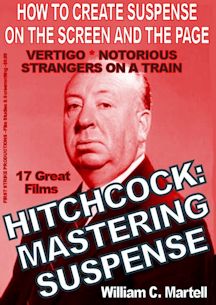
LEARN SUSPENSE FROM THE MASTER!
*** HITCHCOCK: MASTERING SUSPENSE *** - For Kindle!
Alfred Hitchcock, who directed 52 movies, was known as the *Master Of Suspense*; but what exactly is suspense and how can *we* master it? How does suspense work? How can *we* create “Hitchcockian” suspense scenes in our screenplays, novels, stories and films?
This book uses seventeen of Hitchcock’s films to show the difference between suspense and surprise, how to use “focus objects” to create suspense, the 20 iconic suspense scenes and situations, how plot twists work, using secrets for suspense, how to use Dread (the cousin of suspense) in horror stories, and dozens of other amazing storytelling lessons. From classics like “Strangers On A Train” and “The Birds” and “Vertigo” and “To Catch A Thief” to older films from the British period like “The 39 Steps” and “The Man Who Knew Too Much” to his hits from the silent era like “The Lodger” (about Jack The Ripper), we’ll look at all of the techniques to create suspense!
Only $5.99
NO KINDLE REQUIRED! Get the *free* app (any device, except your Mr. Coffee) on the order page on Amazon!
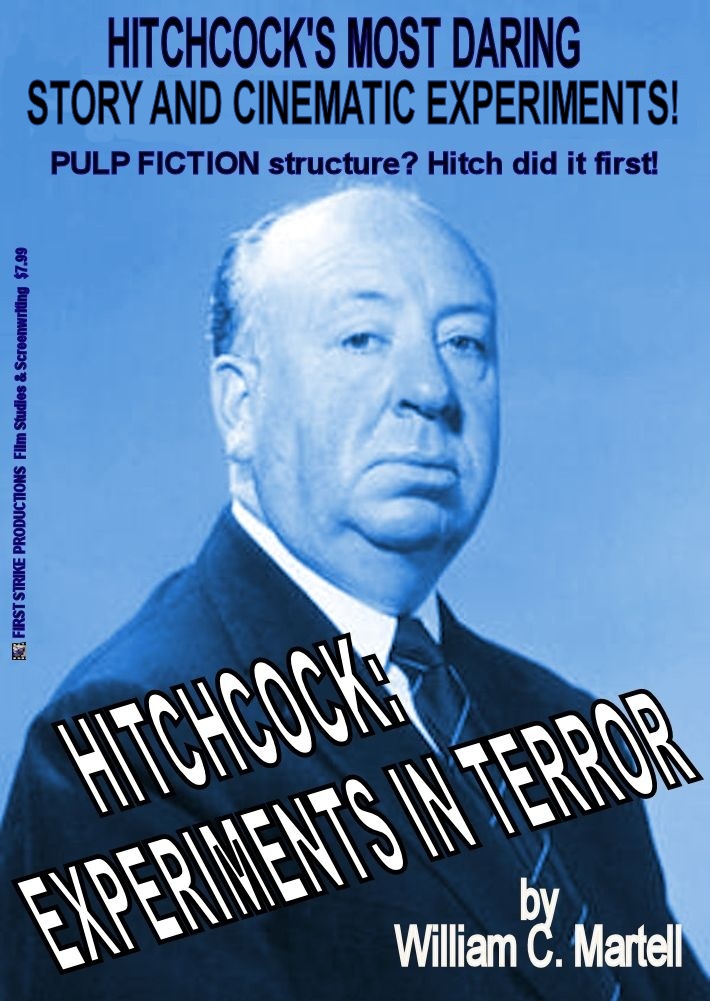
Strange Structures!
*** HITCHCOCK: EXPERIMENTS IN TERROR! *** - For Kindle!
***
Contained Thrillers like "Buried"? Serial Protagonists like "Place Beyond The Pines"? Multiple Connecting Stories like "Pulp Fiction"? Same Story Multiple Times like "Run, Lola, Run"?
HITCHCOCK DID IT FIRST!
This book focuses on 18 of Hitchcock's 52 films with wild cinema and story experiments which paved the way for modern films. Almost one hundred different experiments that you may think are recent cinema or story inventions... but some date back to Hitchcock's *silent* films! We'll examine these experiments and how they work. Great for film makers, screenwriters, film fans, producers and directors.
Only $5.99 - and no postage!
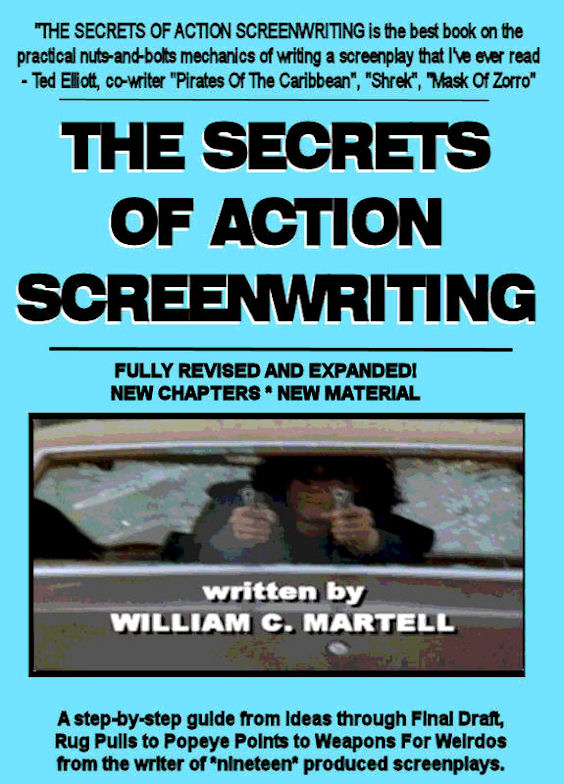
MAKES A GREAT GIFT!
*** THE SECRETS OF ACTION SCREENWRITING *** - For Kindle!
*** THE SECRETS OF ACTION SCREENWRITING *** - For Nook!
Why pay $510 for a used version of the 240 page 2000 version that used to retail for $21.95? (check it out!) when
you can get the NEW EXPANDED VERSION - over 500 pages - for just $9.99? New chapters, New examples, New techniques!
"SECRETS OF ACTION SCREENWRITING is the
best book on the practical nuts-and-bolts mechanics of writing a screenplay I've ever read."
- Ted Elliott, co-writer of MASK OF ZORRO, SHREK, PIRATES OF THE CARIBBEAN and the sequels (with Terry Rossio). (ie; 4 of the top 20 Box Office Hits Of ALL TIME.)
Only $9.99 - and no postage!
Tip FAQ

My New Script Secrets Newsletter!

STORY IN ACTION SERIES!

THE MISSION IMPOSSIBLE MOVIES
NEW: Updates On Films 7 & 8 Casting!
All Six Movies analyzed! All of the mission tapes, all of the “that’s impossible!” set pieces and stunts, the cons and capers - and how these scenes work, the twists and double crosses, the tension and suspense (and how to generate it), the concept of each film as a stand alone with a different director calling the shots (broken in the sixth film), the gadgets, the masks, the stories, the co-stars and team members (one team member has been in every film), the stunts Tom Cruise actually did (and the ones he didn’t), and so much more! Over 120,000 words of fun info!
THE MISSION IMPOSSIBLE MOVIES - 347 Pages - Only $3.99 !

BRAND NEW!
*** THE BOURNE MOVIES
NEW: Updates on TREADSTONE TV show!
All five "Bourne" movies (including "Legacy" and it's potential sequels) - what are the techniques used to keep the characters and scenes exciting and involving? Reinventing the thriller genre...
or following the "formula"? Five films - each with an interesting experiment! A detailed analysis of each
of the films, the way these thrillers work... as well as a complete list of box office and critical
statistics for each film. This book is great for writers, directors, and just fans of the series.
Only $3.99 - and no postage!
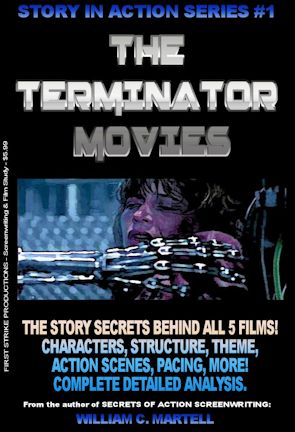
Over 240 pages!
*** THE TERMINATOR MOVIES *** - For Kindle!
He's back! The release of "Terminator: Dark Fate" is set to begin a new trilogy in
the Terminator story... 35 years after the first film was released. What draws us to these films about
a cybernetic organism from the future sent back in time? Why is there a new proposed trilogy every few
years? This book looks at all five Terminator movies from a story standpoint - what makes them work
(or not)? What are the techniques used to keep the characters and scenes exciting and involving? How
about those secret story details you may not have noticed? Containing a detailed analysis of each of
the five films so far, this book delves into the way these stories work... as well as a complete list of
box office and critical statistics for each film. This book is great for writers, directors, and just
fans of the series.
ONLY $3.99 - and no postage!
NO KINDLE REQUIRED! Get the *free* app (any device, except your Mr. Coffee) on the order page on Amazon!

NEW BUT OLD!
*** VINTAGE #1: HOW TO WRITE PHOTOPLAYS *** - For Kindle!
***
Screenwriting books have been around as long as films have. This series reprints vintage screenwriting books with a new introduction and history, plus new articles which look at how these lessons from almost 100 years ago apply to today’s screenplays. Anita Loos book is filled with information which still applies.
In addition to the full text of the original book, you get the full screenplay to Miss Loos' hit THE LOVE EXPERT, plus several new articles on the time period and women in Hollywood.
Only $2.99 - and no postage!
THE BLUE BOOKS!
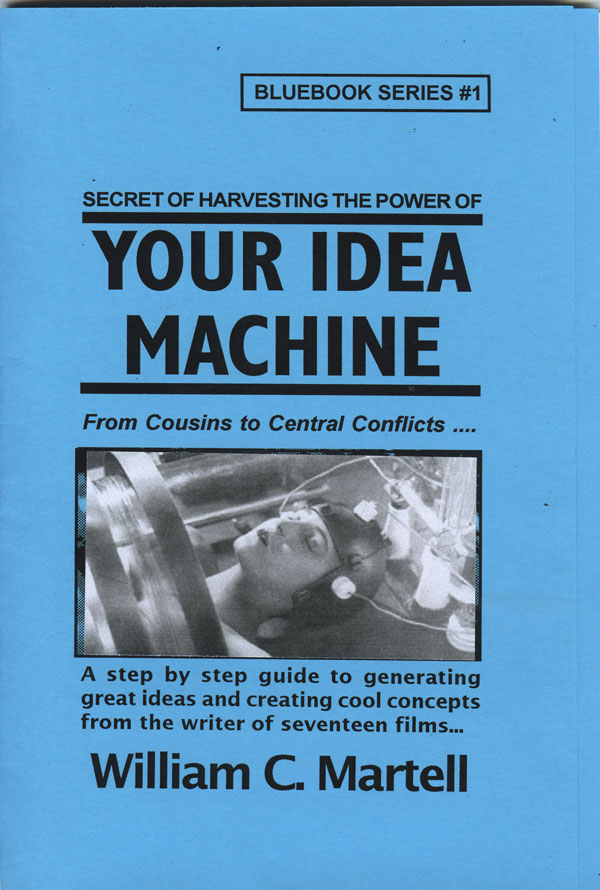
FIND A GREAT IDEA!
*** YOUR IDEA MACHINE *** - For Kindle!
****
Expanded version with more ways to find great ideas! Your screenplay is going to begin with an idea. There are good ideas and bad ideas and commercial ideas and personal ideas. But where do you find ideas in the first place? This handbook explores different methods for finding or generating ideas, and combining those ideas into concepts that sell. The Idea Bank, Fifteen Places To Find Ideas, Good Ideas And Bad Ideas, Ideas From Locations And Elements, Keeping Track Of Your Ideas, Idea Theft - What Can You Do? Weird Ways To Connect Ideas, Combing Ideas To Create Concepts, High Concepts - What Are They? Creating The Killer Concept, Substitution - Lion Tamers & Hitmen, Creating Blockbuster Concepts, Magnification And The Matrix, Conflict Within Concept, Concepts With Visual Conflict, Avoiding Episodic Concepts, much more! Print version is 48 pages, Kindle version is over 175 pages!
Only $4.99 - and no postage!
FIGURE OUT YOUR STORY!
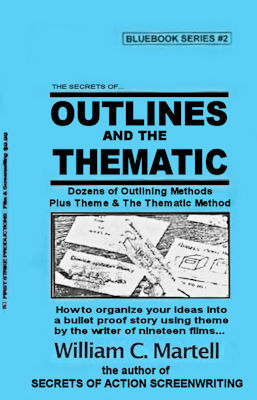
OUTLINES & THE THEMATIC Blue Book.
ARE YOUR SCENES IN THE RIGHT ORDER?
AND ARE THEY THE RIGHT SCENES?
Your story is like a road trip... but where are you going? What's the best route to get there? What are the best sights to see along the way? Just as you plan a vacation instead of just jump in the car and start driving, it's a good idea to plan your story. An artist does sketches before breaking out the oils, so why shouldn't a writer do the same? This Blue Book looks at various outlining methods used by professional screenwriters like Wesley Strick, Paul Schrader, John August, and others... as well as a guest chapter on novel outlines. Plus a whole section on the Thematic Method of generating scenes and characters and other elements that will be part of your outline. The three stages of writing are: Pre-writing, Writing, and Rewriting... this book looks at that first stage and how to use it to improve your screenplays and novels.
Only $4.99 - and no postage!
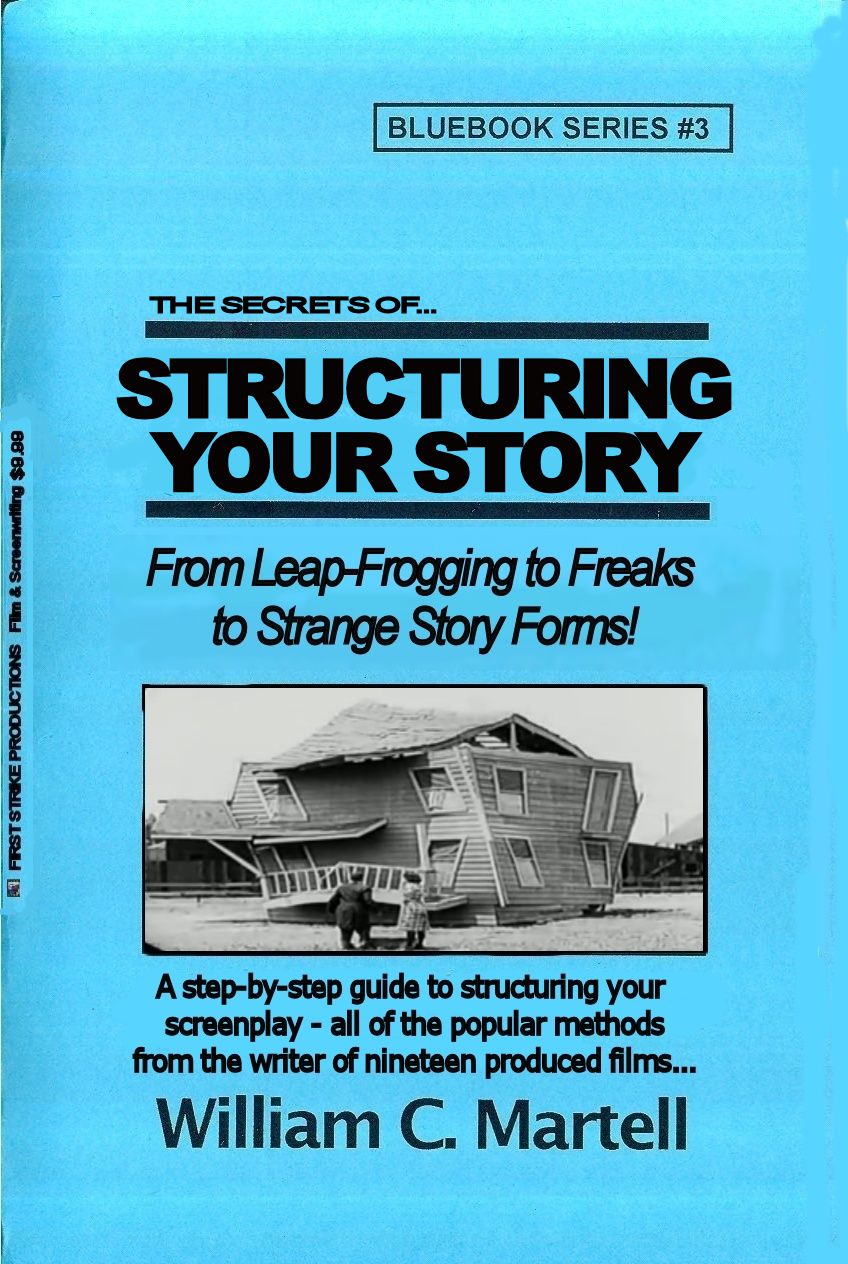
GOT STRUCTURE?!
*** STRUCTURING YOUR STORY *** - For Kindle!
William Goldman says the most important single element of any screenplay is structure. It’s the skeleton under the flesh and blood of your story. Without it, you have a spineless, formless, mess... a slug! How do you make sure your structure is strong enough to support your story? How do you prevent your story from becoming a slug? This Blue Book explores different types of popular structures from the basic three act structure to more obscure methods like leap-frogging. We also look at structure as a verb as well as a noun, and techniques for structuring your story for maximum emotional impact. Most of the other books just look at *structure* and ignore the art of *structuring* your story. Techniques to make your story a page turner... instead of a slug!
Only $4.99 - and no postage!

STORY: WELL TOLD!
*** STORY: WELL TOLD *** - For Kindle!
This book takes you step-by-step through the construction of a story... and how to tell a story well, why Story always starts with character... but ISN'T character, Breaking Your Story, Irony, Planting Information, Evolving Story, Leaving No Dramatic Stone Unturned, The Three Greek Unities, The Importance Of Stakes, The Thematic Method, and how to create personal stories with blockbuster potential. Ready to tell a story?
Print version was 48 pages, Kindle version is over 85,000 words - 251 pages!
Only $4.99 - and no postage!

START STRONG!
*** HOOK 'EM IN TEN *** - For Kindle!
Your story doesn't get a second chance to make a great first impression, and this book shows you a
bunch of techniques on how to do that. From the 12 Basic Ways To Begin Your Story, to the 3 Stars Of
Your First Scene (at least one must be present) to World Building, Title Crawls, Backstory, Starting
Late, Teasers and Pre Title Sequences, Establishing Theme & Motifs (using GODFATHER PART 2), Five Critical
Elements, Setting Up The Rest Of The Story (with GODFATHER), and much more! With hundreds of examples
ranging from Oscar winners to classic films like CASABLANCA to some of my produced films (because
I know exactly why I wrote the scripts that way). Biggest Blue Book yet!
Print version was 48 pages, Kindle version is over 100,000 words - 312 pages!
Only $4.99 - and no postage!
NO KINDLE REQUIRED! Get the *free* app (any device, except your Mr. Coffee) on the order page on Amazon!
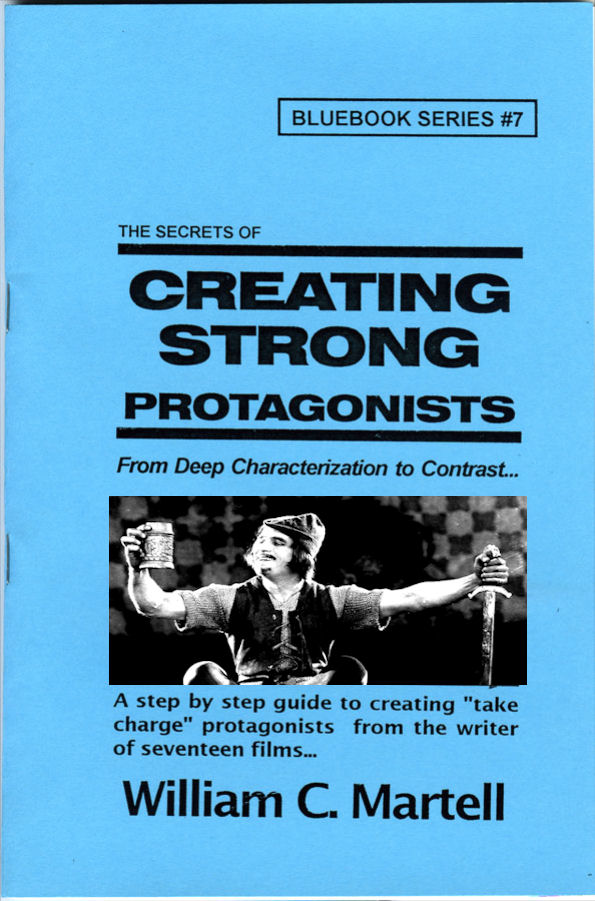
MOVIES ARE CHARACTERS!
*** CREATING STRONG PROTAGONISTS *** - For Kindle!
*** CREATING STRONG PROTAGONISTS *** - For Nook!
Expanded version with more ways to create interesting protagonists! A step-by-step guide to creating "take charge" protagonists. Screenplays are about characters in conflict... characters in emotional turmoil... Strong three dimensional protagonists who can find solutions to their problems in 110 pages. But how do you create characters like this? How do you turn words into flesh and blood? Character issues, Knowing Who Is The Boss, Tapping into YOUR fears, The Naked Character, Pulp Friction, Man With A Plan, Character Arcs, Avoiding Cliche People, Deep Characterization, Problem Protagonists, 12 Ways To Create Likable Protagonists (even if they are criminals), Active vs. Reactive, The Third Dimension In Character, Relationships, Ensemble Scripts, and much, much more. Print version is 48 pages, Kindle version is once again around 205 pages!
ONLY $4.99 - and no postage!
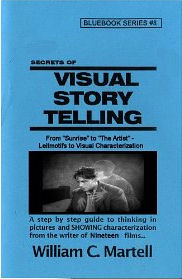
I WRITE PICTURES!
*** VISUAL STORYTELLING *** - For Kindle! (exclusive)
Show Don't Tell - but *how* do you do that? Here are techniques to tell stories visually! Using Oscar Winning Films and Oscar Nominated Films as our primary examples: from the first Best Picture Winner "Sunrise" (1927) to the Oscar Nominated "The Artist" (which takes place in 1927) with stops along the way Pixar's "Up" and Best Original Screenplay Winner "Breaking Away" (a small indie style drama - told visually) as well as "Witness" and other Oscar Winners as examples... plus RISE OF THE PLANET OF THE APES. Print version is 48 pages, Kindle version is over 200 pages!
ONLY $4.99 - and no postage!
DESCRIPTION & VOICE Blue Book!
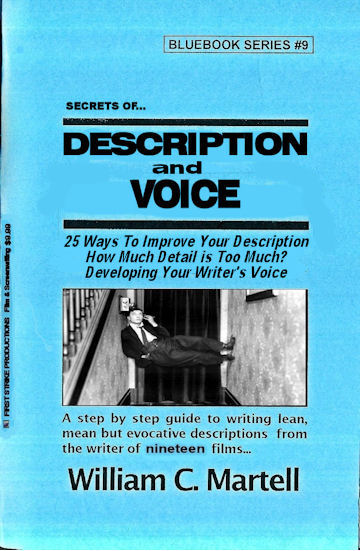
DESCRIPTION & VOICE Blue Book.
IS HALF OF YOUR STORY IN TROUBLE?
Most screenplays are about a 50/50 split between dialogue and description - which means your description is just as important as your dialogue. It just gets less press because the audience never sees it, the same reason why screenwriters get less press than movie stars. But your story will never get to the audience until readers and development executives read your script... so it is a very important factor. Until the movie is made the screenplay is the movie and must be just as exciting as the movie. So how do you make your screenplay exciting to read? Description is important in a novel as well, and the “audience” does read it... how do we write riveting description?
Only $4.99 and no postage!

PRO DIALOGUE TECHNIQUES!
*** DIALOGUE SECRETS *** - For Kindle!
***
Expanded version with more ways to create interesting dialogue! How to remove bad dialogue (and what *is* bad dialogue), First Hand Dialogue, Awful Exposition, Realism, 50 Professional Dialogue Techniques you can use *today*, Subtext, Subtitles, Humor, Sizzling Banter, *Anti-Dialogue*, Speeches, and more. Tools you can use to make your dialogue sizzle! Special sections that use dialogue examples from movies as diverse as "Bringing Up Baby", "Psycho", "Double Indemnity", "Notorious", the Oscar nominated "You Can Count On Me", "His Girl Friday", and many more! Print version is 48 pages, Kindle version is over 175 pages!
Only $4.99 - and no postage!

WHAT IS A SCENE?
*** SCENE SECRETS *** - For Kindle!
***
What is a scene and how many you will need? The difference between scenes and sluglines. Put your scenes on trial for their lives! Using "Jaws" we'll look at beats within a scene. Scene DNA. Creating set pieces and high concept scenes. A famous director talks about creating memorable scenes. 12 ways to create new scenes. Creating unexpected scenes. Use dramatic tension to supercharge your scenes. Plants and payoffs in scenes. Plus transitions and buttons and the all important "flow"... and more! Over 65,000 words! Print version was 48 pages, Kindle version is around 210 pages!
Only $4.99 - and no postage!
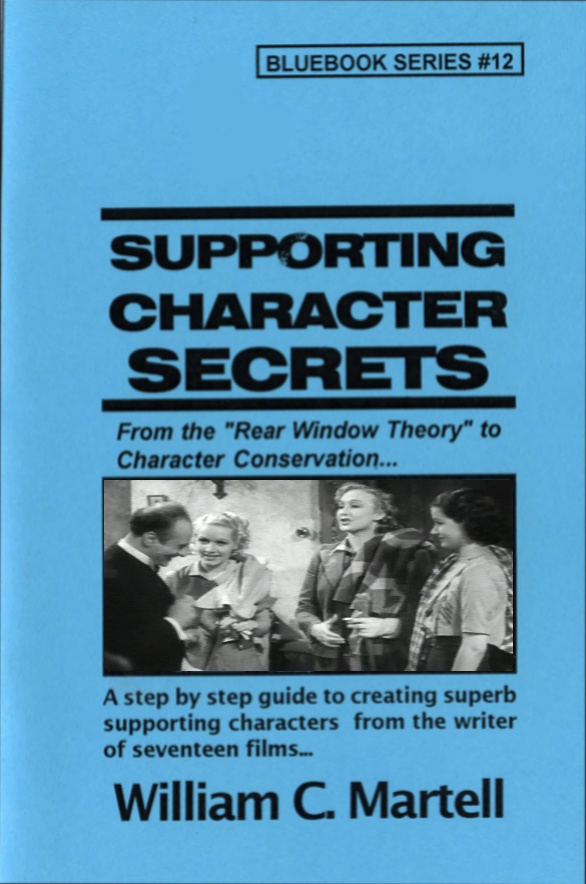
SUBPLOTS?
*** SUPPORTING CHARACTER SECRETS *** - For Kindle! (Exclusive)
Expanded version with more techniques to flesh out your Supporting Characters and make them individuals. Using the hit movie BRIDESMAIDS as well as other comedies like THE HANGOVER and TED and HIGH FIDELITY and
40 YEAR OLD VIRGIN and many other examples we look at ways to make your Supporting Characters come alive on the page.
Print version was 48 pages, Kindle version is around 170 pages!
ONLY $4.99 - and no postage!
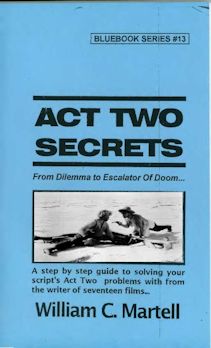
ACT TWO SOLUTIONS!
*** ACT TWO SECRETS *** - For Kindle!
Expanded version with more techniques to help you through the desert of Act Two! Subjects Include: What Is Act Two? Inside Moves, The 2 Ps: Purpose & Pacing, The 4Ds: Dilemma, Denial, Drama and Decision, Momentum, the Two Act Twos, Subplot Prisms, Deadlines, Drive, Levels Of Conflict, Escalation, When Act Two Begins and When Act Two Ends, Scene Order, Bite Sized Pieces, Common Act Two Issues, Plot Devices For Act Two, and dozens of others. Over 67,000 words (that’s well over 200 pages) of tools and techniques to get you through the desert of Act Two alive!
Print version was 48 pages, Kindle version is well over 200 pages!
ONLY $4.99 - and no postage!
All About Endings!
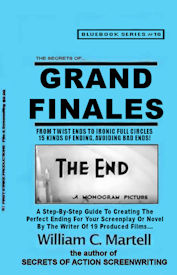
GRAND FINALES Blue Book!
The Perfect Ending For Your Story!
The First Ten Pages Of Your Screenplay Are Critical,
But What About The Last 10 Pages?
Creating the perfect ending to your story! This 100,000 word book shows you how to end your story with a bang, rather than a whimper. Everything from Resolution Order to Act Three Tools to Happy or Sad Endings? to How The Beginning Of Your Story Has Clues To The Ending (in case you were having trouble figuring out how the story should end) to Falling Action to How To Avoid Bad Endings to Writing The Perfect Twist Ending to Setting Up Sequels & Series to Emotional Resolutions to How To Write Post Credit Sequences to Avoiding Deus Ex Machinas, to 20 Different Types Of Ends (and how to write them) and much more! Everything about endings for your screenplay or novel!
Only: $4.99
NO KINDLE REQUIRED! Get the *free* app (any device, except your Mr. Coffee) on the order page on Amazon!
All About LOGLINES, TREATMENTS, and PITCHING!

LOGLINES, TREATMENTS, and PITCHING! Blue Book!
Distilling Your Screenplay!
Loglines, Treatments, Pitching, Look Books, Pitch Decks, One Pagers, Rip-O-Matics?
You have written a brilliant 110 page screenplay, but how do you get anyone to read it? You need to distill it down into some form of verbal moonshine or story rocket fuel that will ignite that bored development executive or manager or agent and get them to request your screenplay. But how do you shrink those 110 pages into a 25 word logline or a 2 minute elevator pitch or a one page synopsis or a short paragraph? This 100,000 word book shows you how! Everything you need to know! From common logline mistakes (and how to solve them) to how your pitch can reveal story problems to the 4 types of pitches!
272 Pages - ONLY $4.99!
READY TO BREAK IN?
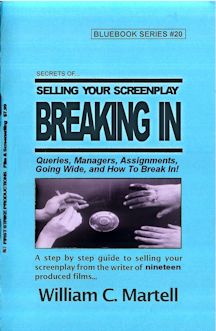
THE BUISINESS SIDE
*** BREAKING IN BLUE BOOK *** - For Kindle!
Should really be called the BUSINESS BLUE BOOK because it covers almost everything you will need to
know for your screenwriting career: from thinking like a producer and learning to speak their language,
to query letters and finding a manager or agent, to making connections (at home and in Hollywood) and
networking, to the different kinds of meetings you are will have at Studios, to the difference between
a producer and a studio, to landing an assignment at that meeting and what is required of you when you
are working under contract, to contracts and options and lawyers and... when to run from a deal!
Information you can use *now* to move your career forward! It's all here in the Biggest Blue Book yet!
Print version was 48 pages, Kindle version is over 400 pages!
$4.99 - and no postage!

Use your creative energy to focus on the content; let Final Draft take care of the style. Final Draft is the number-one selling application specifically designed for writing movie scripts, television episodics and stage plays. Its ease-of-use and time-saving features have attracted writers for almost two decades positioning Final Draft as the Professional Screenwriters Choice. Final Draft power users include Academy, Emmy and BAFTA award winning writers like Oliver Stone, Tom Hanks, Alan Ball, J.J. Abrams, James Cameron and more.
* * * Buy It!
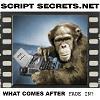
|
|
|
|
|
SECRETS OF ACTION SCREENWRITING
|
|
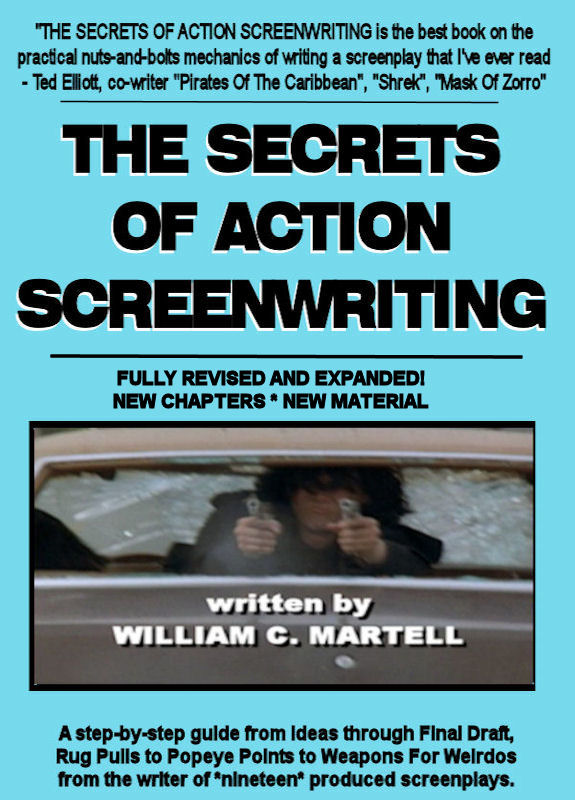 IT'S BACK! SECRETS OF ACTION SCREENWRITING
IT'S BACK! SECRETS OF ACTION SCREENWRITING
Over 460 pages packed with tips and techniques.
How to
write a plot twist,
the four kinds of suspense (and how to create it), reversals, ten ways to invent new action scenes, secrets and lies,
creating the ultimate
villain, five kinds of love interests, MORE! CLICK HERE!
|
|
CLASSES ON MP3
|
|
 CLASSES ON MP3! Take a class on MP3! GUERRILLA MARKETING - NO AGENT? NO PROBLEM! and WRITING THRILLERS (2 MP3s). Full length classes on MP3. Now Available: IDEAS & CREATIVITY, WRITING HORROR, WRITING INDIE FILMS, more!
CLASSES ON MP3! Take a class on MP3! GUERRILLA MARKETING - NO AGENT? NO PROBLEM! and WRITING THRILLERS (2 MP3s). Full length classes on MP3. Now Available: IDEAS & CREATIVITY, WRITING HORROR, WRITING INDIE FILMS, more!
Take classes on MP3!
|
|
MY OTHER SITES
|
|
B MOVIE WORLD
Cult Films, Exploitation, Bikers & Women In Prison, Monster Movies.
FIRST STRIKE PRODUCTIONS
Producing my own scripts, investment possibilities, pipe dreams.
|
|
NAKED SCREENWRITING MP3s
|
|
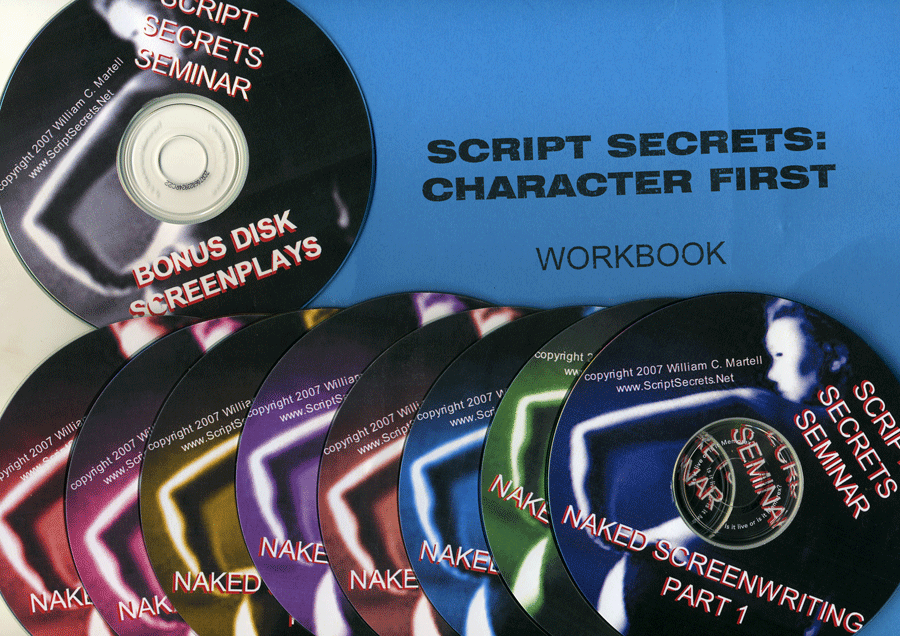 The NAKED SCREENWRITING CLASS ON MP3!
The 2001 London Class on 8 MP3s! Recorded *live* the morning after the Raindance Film Festival
wrapped. The two day class on 8CD worth, plus a workbook, plus a bonus CD.
The NAKED SCREENWRITING CLASS ON MP3!
The 2001 London Class on 8 MP3s! Recorded *live* the morning after the Raindance Film Festival
wrapped. The two day class on 8CD worth, plus a workbook, plus a bonus CD.
The 2 Day Class on MP3!
|
|
ONLINE CLASSES
|
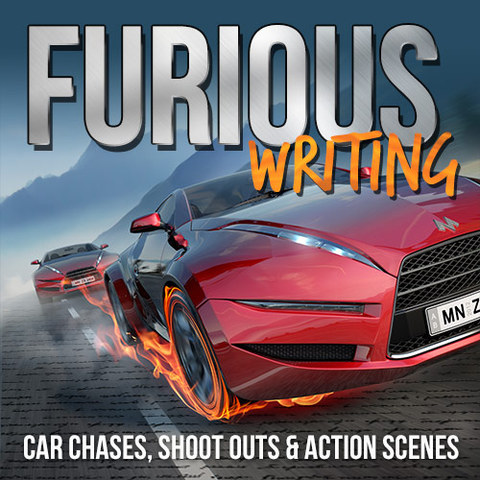
|
|
BILL'S CORNER
|
|
My
nineteen produced films, interviews with me in magazines,
several sample scripts, my available scripts list... And MORE!
...............................BILL'S CORNER
Available Scripts
|
|
E BOOKS PAGE
|
|
 E BOOKS: New Blue Books and Novelettes!
E BOOKS: New Blue Books and Novelettes!
I am expanding all of the Blue Books from around 44 pages of
text to around 200 pages! Some are over 250 pages! See what is availabale and what is coming soon!Also, I've been writing Novelletes and there
will soon be novels.
E BOOKS: BLUE BOOKS & NOVELLETES
|
|
BOOKLETS & PRODUCTS
|
|
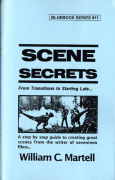 FIRST STRIKE BLUE BOOKS
FIRST STRIKE BLUE BOOKS
Each Blue Book is 48
pages and focuses on a different aspect of screenwriting. Dialogue. Visual Storytelling. Your First Ten Pages. Act 2 Booster. Protagonists. Great Endings.
Seventeen Blue Books now available!
THE SECRETS OF ACTION SCREENWRITING OUT OF PRINT!
|
|
|
|
|

